Hippeastrum is a gorgeous flowering bulb that might make you think of Christmas, depending what part of the world you are from. If you need a bit of tropical in your garden or home, this bright delight will certainly chase away the blues.
In our growing guide, we’ll look at how to grow the Hippeastrum, care guidelines in terms of sunlight, soil and watering, the main diseases that affect this plant, and some frequently asked questions.
More...
Genus: | Hippeastrum |
|---|---|
Family: | Amaryllidaceae |
Common name: | Amaryllis |
Plant type: | Bulbs |
Height: | Up to 75cm |
Spread: | Up to 20cm |
Sunlight: | Full sun/part shade |
Soil Type: | Well-drained |
Maintenance level: | Medium |
Poisonous to pets: | Yes |
Introducing Hippeastrum
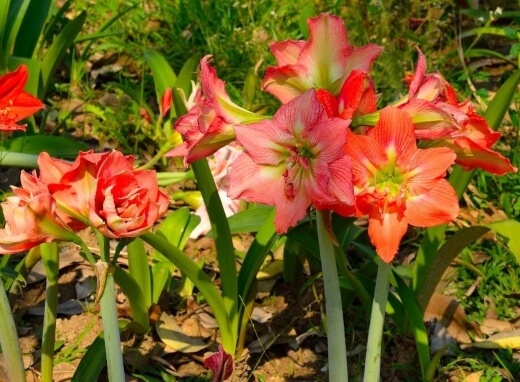
Hippeastrum is a genus of about 90 species and over 600 hybrids and cultivars. These plants generally have big fleshy bulbs and large leaves, with red or purple flowers.
The name Hippeastrum was given by William Herbert, and it means "knight's star". We’re not exactly sure what Herbert meant by the name though.
For a long time, there was a lot of confusion among botanists over the generic names Amaryllis and Hippeastrum.
Amaryllis and Hippeastrum Clarification

Let’s clarify - the common name Amaryllis is used for cultivars of this genus that are usually sold as indoor flowering bulbs at Christmas in the northern hemisphere.
(Speaking of Christmas, be sure to check out our comprehensive guide to growing NSW Christmas bush which you will surely love.)
The generic name Amaryllis applies to bulbs from South Africa that are usually grown outdoors. The genus is native to tropical and subtropical regions from Argentina north to Mexico and the Caribbean.
The real Amaryllis is an outdoor flowering plant, the most popular being the Belladonna Lily or Naked Lady. The plant is unique because the flowers appear without any leaf support.
Hippeastrum is related to Amaryllis but has been cultivated so they can grow indoors and will bloom in the winter months. The shape and colours of the flowers are more varied than the outdoor Amaryllis which makes them more popular.
It was only around 1987 that it was decided how the plants should be named, but it's still very common to find people calling Hippeastrum, "Amaryllis" and vice versa.
Hippeastrum Varieties
Sonatini Hippeastrums

Source: tesselaar.net.au
These are a more compact hybrid which is cold hardy and produces more flowers than other hippeastrums. It’s a smaller and more compact bulb with multiple stems and more flower buds per stem.
Sonatini varieties grow shorter and they are more suitable for potting or in the garden, with no need to lift them in winter.


Get Your Free Guide:
Master Growing Australian Natives eBook
A Must Have Complete Guide for Every Australian Garden
Get Your Free Guide:
Master Growing Australian Natives eBook
A Must Have Complete Guide for Every Australian Garden
Speciality Hippeastrums
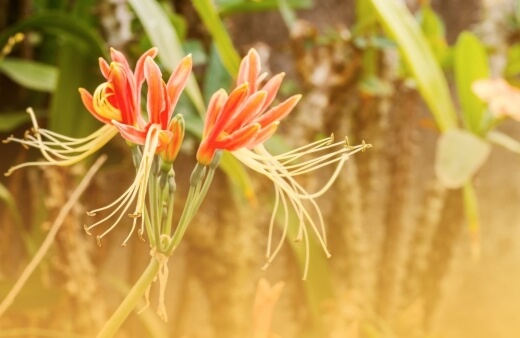
These are rare hippeastrums and are in very limited supply. The “Spider” or Cybister Hippeastrum are unique two toned flowers, and are even more breathtaking than the other varieties (if that’s even possible).
How to Grow Hippeastrum
The hippeastrum will rot easily if over watered or when exposed to even a mild frost. Don't plant it outside when it’s finished flowering or keep it outside when the temperatures drop.
The size of the bulb determines the size and number of flowering stems. A large heavy bulb might produce three flowering stems where a smaller one might only produce one stem.
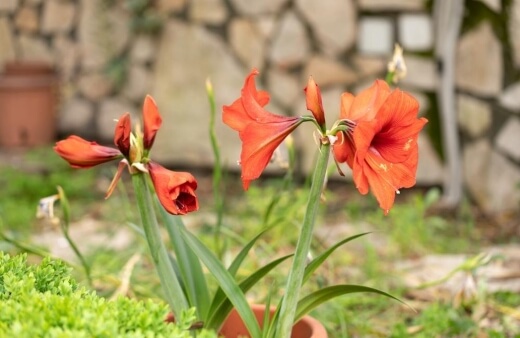
Hippeastrum's Lifecycle
- Dormant Bulb – in this phase there is no growth but there may be a tiny bit of green here and there. At this stage all you need to do is "wake" the bulb, meaning it should flower within two months.
- Waking the Bulb - The bulb should be planted in good quality compost with only the bottom half of the bulb actually covered. Water it well once and then move it indoors to a warm and semi bright location.
A few leaves and the flower stalks will start to grow from the top over the next month. Don't keep watering the plant at this stage. Only when the flower stalks are clearly visible a few centimetres above the bulb, you can then aim to keep the soil just moist. - Flowering – a few weeks later, the flower stem will grow quickly and open. Sometimes one stem will flower and when it fades the next one will start. Even though each flower doesn’t bloom for long, the overall display of flowers can last up to a month.
- Leaf Growth – once the flowering period is over, you can remove the dead flowers. The leaves will now fully emerge and grow. Water well and feed the plant regularly for the next few months.
- Triggering Dormancy – at the end of summer or start of autumn, you can reduce watering. If the plant is outside, this will cause the leaves to start yellowing and dying back.
Eventually you will see just a stray leaf or the bulb itself. You can now move the bulb to a cool but frost free place for about two months. The soil needs to be dry so don't water at all during this time.
You also don’t want to provide warmth as too much heat and water can prevent or break the dormancy period. After this "rest" period, the cycle is complete and can be started again.
Planting Hippeastrum
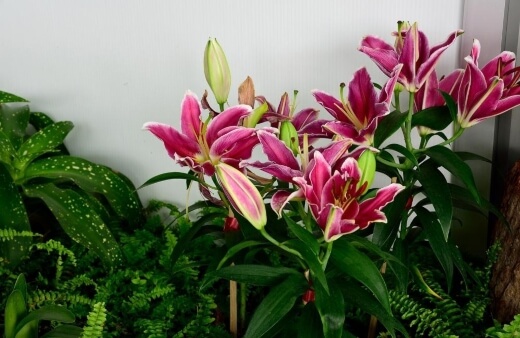
Where to Plant Hippeastrum
Hippeastrums like full sun or light shade. Try to plant them near a wall or fence so that they’re protected from strong winds, but at the same time getting plenty of sunlight.
They are drought-hardy plants and able to survive on almost no rainfall for a year or two. Their flowers might be affected though. Hippeastrums are supplied as a dormant bulb.
You’ll need to unpack it immediately and keep it in an airy place until ready to plant. Make sure the roots don’t dry out too much.
How to Plant Hippeastrum
If you’re planting in the garden, plant the bulbs in well-drained soil and put at least a spade full of decayed animal manure under each bulb. You want to leave the top third of the bulb peeking out of the soil.
If you’re using a pot, you can plant at the same depth. Choose a pot large enough for a minimum of 3-4cm of soil around the bulb. The top of the bulb should be protruding from the top of the pot. A 15cm pot is a good guideline.
If the hippeastrum is planted in full sunlight, it should flower in about 5 weeks. If the budding of the flower is happening too quickly, you can place the pot in a cooler position to slow down the process.
If flowering is too slow, place it in a warmer position with more sunlight. Once you notice that the flower buds have separated at the top of the stem, it means flowering will happen in about 3-4 days.
Hippeastrum Growth Speed
You should have flowers on your plant within two months of the plant waking from the dormancy period. Warm temperatures speed up the growth enormously.
The flowers will often fade up to a month after first opening. Over the following months, green leaves will grow and extend from the bulb. These will eventually die back closer to autumn as things get cooler and if you reduce watering.
Height and Spread
Sometimes the flowering stem can be up to 75cm with huge blooms that need support to keep them upright. They can also be compact and dainty. It's common to get four or five vibrant flowers per main flower stem.
If the bulb is small or still young then there will probably only be one flower stem. Each flower is often between 13–20cm in many different colours and patterns.
They're usually funnel shaped, especially with the single varieties, but they also come in a double form. The "traditional" hippeastrum usually has six petals.
Hippeastrum Propagation
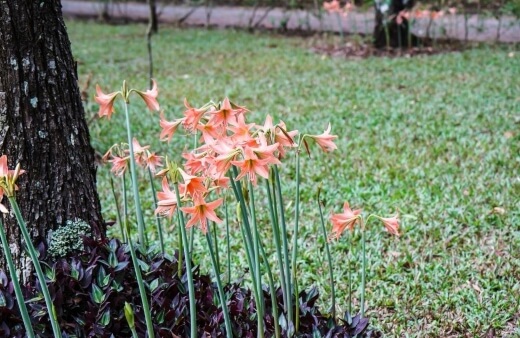
Hippeastrum will produce offsets often but they take a very long time to reach a really good size, which is needed before they will produce flowers of their own.
Generally it’s best to leave the offsets next to the parent plant for a few years. Eventually the offsets will be big enough to be separated from the parent bulb.
To do this, remove the entire plant and gently remove the offset. It will have some of its own roots which you can carefully detangle and ensure the offset takes some with it when separated.
Hippeastrum Care Guide
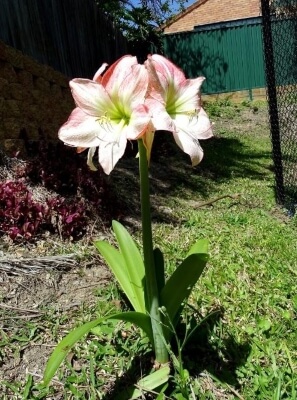
Sunlight Needs
This plant needs bright light and some sun for part of its day if you want to see flowers appear each year. If there is too little light during flowering, the stalks start bending towards light and it might end up falling over.
Best Soil for Hippeastrum
Hippeastrum will do well with well-drained soil enriched with organic matter. They are quite adaptable to most soil types, but aren’t keen on very sandy soil. In pots, you can use a good quality potting or bulb mix. Place some pieces of stone at the bottom of the pot to help with drainage.
Watering Schedule
When the plant is in the dormant state, you should water enough to make sure the soil is evenly moist. Wait until growth starts before watering again.
When the plant is in the active growing phase (when the leaves have fully emerged) and the temperature is warm, keep the soil moist most of the time.
Reduce watering towards autumn and then eventually you can stop completely. It's very easy to cause a hippeastrum bulb to rot from overwatering so just make sure the bulb doesn’t sit in water at any time.
Water it regularly during the flowering season and hotter months but hold off once the foliage has browned and fallen off.
Humidity
Hippeastrum is not fussy about humidity. That being said, very humid locations will need less watering overall than places which are very arid as the soil will take longer to dry out.
What Fertiliser to Use
You only need to feed your hippeastrum when the flowers have wilted and the leaf straps have appeared. Try and fertilise every few weeks during the summer and stop just before autumn starts.
This helps the bulb "fatten" up to create some flowers early the following year.
Temperature
Warmth along with a bit of moisture will wake up a dormant bulb, and then if you keep it warm you'll have lots of flowers in a short space of time. If you keep the same warmth when the flowers are about to open and straight after this, the flowering period will be short.
If you want to slow the process down or to prolong the life of the flowers once they've opened up, then it’s best to cool the temperature down.
Just like a bunch of cut flowers, they'll last longer if you keep them out of direct sunlight and in a cooler room. Hippeastrum can’t deal with cold conditions and certainly not frost.
Repotting Hippeastrum
Repotting a hippeastrum is only necessary if the original pot is very small or the plant has produced so many offsets that it needs more space. You don’t need to repot each year or to even remove the bulb from the existing pot during the rest period.
If you ever do repot, make sure the new container is only a little bigger than the previous one and use a good quality compost. The bulb only needs to be half covered otherwise it might rot.
Additional Care Tips for Hippeastrum
- Leave the top third of the bulb above the soil. Unlike most other bulb flowers the amaryllis does not like growing beneath the surface and will rot and die if you plant it that way.
- Don’t move it for the next 3 years. The Amaryllis is not a big fan of change and much prefers to get comfortable in its surroundings so resist the temptation to dig it up every year and dry the bulb out – they don’t work that way.
Growing Hippeastrum in Containers
Hippeastrum is best grown in a container for a few good reasons. First, you have the flexibility of location changes when they’re in pots than you would have if they were stuck in the ground.
Second, this flexibility means you can remove the plant from the public eye once its blooms are spent and allow it to recuperate without messing up your garden. Finally, growing in a container allows you to bring these bulbs indoors and take care of them during the cooler months.
Pests and Diseases that Affect Hippeastrum
The most common problems that affect hippeastrums are caused by microorganisms. Insect pests can often be dealt with without removing parts of the plant, but with these infectious organisms, you need to get rid of the affected and infected plant parts. This also helps prevent the infection from spreading to nearby plants.
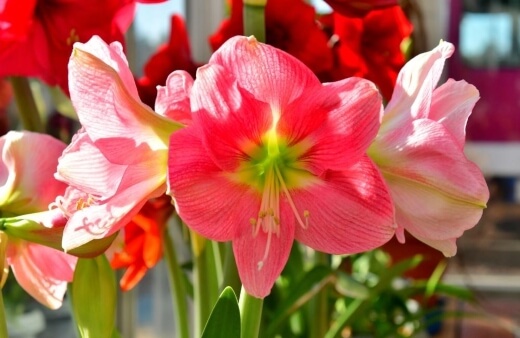
Red blotch/ Leaf Scorch
Red blotch or leaf scorch is a fungal disease. It shows up as red spots on leaves and flower stems and causes them to break and wither. This disease is endemic to all members of the Amaryllis family, but is more commonly found on hippeastrums.
The fungus can be carried on the bulbs, so if you remove the infected stalks it won’t fix the problem. Symptoms of this disease in bulbs are red spots with clear margins which then become soft sunken patches on the bulb. Sometimes it even goes through several layers.
Badly infected bulbs need to be removed and destroyed. Moderate to mild infections can be managed with a fungicide on a regular basis. Try to avoid overhead watering and getting the leaves wet, and regularly spray foliage with a fungicide.
An important time for this is as the bulbs are beginning to go dormant. This is when infections can return to the bulb. When weather becomes cool and wet it causes ideal conditions for active spores to spread.
Mosaic virus
Mosaic virus creates yellow streaks on the plant’s leaves and these become more intense over time. You might not even notice this symptom until the leaves have matured.
The infection gradually reduces the plant’s growth and it will stop flowering. There is no treatment unfortunately. Infected plants will need to be thrown away so they don’t spread the disease.
Bulb/root rot
The bulbs are prone to rot. This is caused by fungal and bacterial organisms in the soil, especially if there is poor drainage or overwatering.
Rotting bulbs let you know by their colour and texture, and sometimes even their smell. They need to be discarded to avoid spreading infection.
Grey mould
Grey mould is also known as botrytis blight and is a fungal infection that causes spotting, discolouration, wilting and decay. Greyish-brown spore masses will be seen on affected areas of the plant.
These plant parts will need to be removed and thrown away. Make sure there is sufficient air circulation around plants, remove dead flowers and don’t let the plant become overly damp.
Hippeastrum Frequently Asked Questions
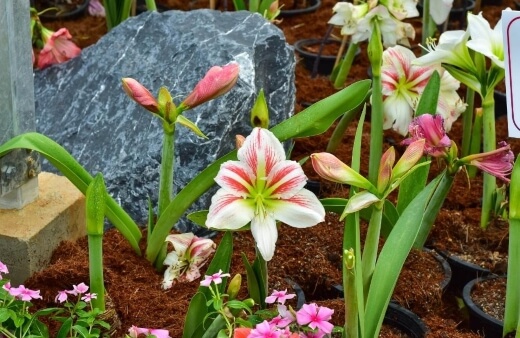
Why is my hippeastrum bulb rotting?
This usually happens if there has been exposure to frost or if the plant has been overwatered. If you think the soil is moist enough, leave it. A heavily rotten bulb usually means there is no hope left for the plant.
Why has the flower stalk gone yellow?
After flowering, the flower stalks start to go yellow and die. You don’t need to cut them off immediately as the energy is going back into the bulb. When all the green has gone you can then remove them.
Why are there no flowers on my hippeastrum?
The bulb is probably too young, too small or something happened during the growth cycle.
Why does my plant have floppy or lanky leaves?
This is common when temperatures move between hot and cold and vice versa. The leaves or flowering stalk can recover if you provide some structural support.
Why does my hippeastrum keep falling over?
Many hippeastrum have been bred to produce amazing flowers but these varieties will need some support to stop them falling over. You could use a wooden or plastic stick to support the flowering stem.
Is hippeastrum poisonous?
There are toxic compounds within the plant. They are sparse in the stem, leaves and flowers but quite concentrated in the bulb, so keep an eye on inquisitive pets.
Have you signed up to our newsletter? We love sharing our top gardening tips for everyday people. Enjoy product reviews, featured plants, links to resources and so much more!
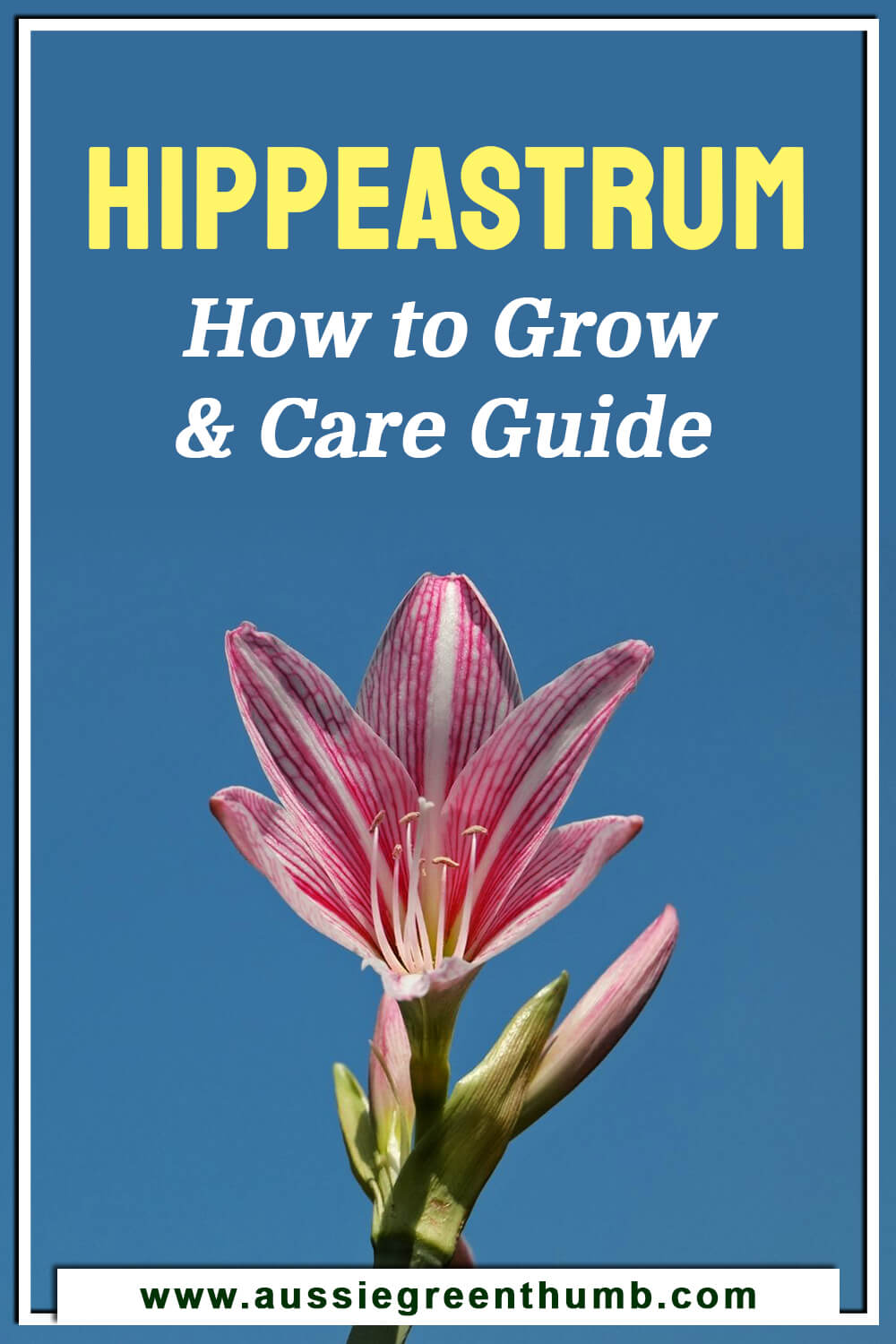
Wrapping up Our Hippeastrum guide
The striking flowers produced by the hippeastrum are a real feast for the eyes. Once you understand how to grow and care for this bulb with a few easy tips, you’re well on your way to enjoying a worthy garden investment.
Familiarising yourself with the hippeastrum lifecycle is your best bet to maintaining a happy and healthy plant (and enjoying the offsets that it produces).
We might not know exactly why it’s called the knight’s star, but hippeastrum certainly brings wonder and beauty to a home and garden.
Published on June 21, 2022 by Maisie Blevins
Last Updated on October 4, 2025





Very informative articles, thank you, Lyn
Hi Lyn,
We’re happy you find our articles informative.
All the best,
Gary Clarke